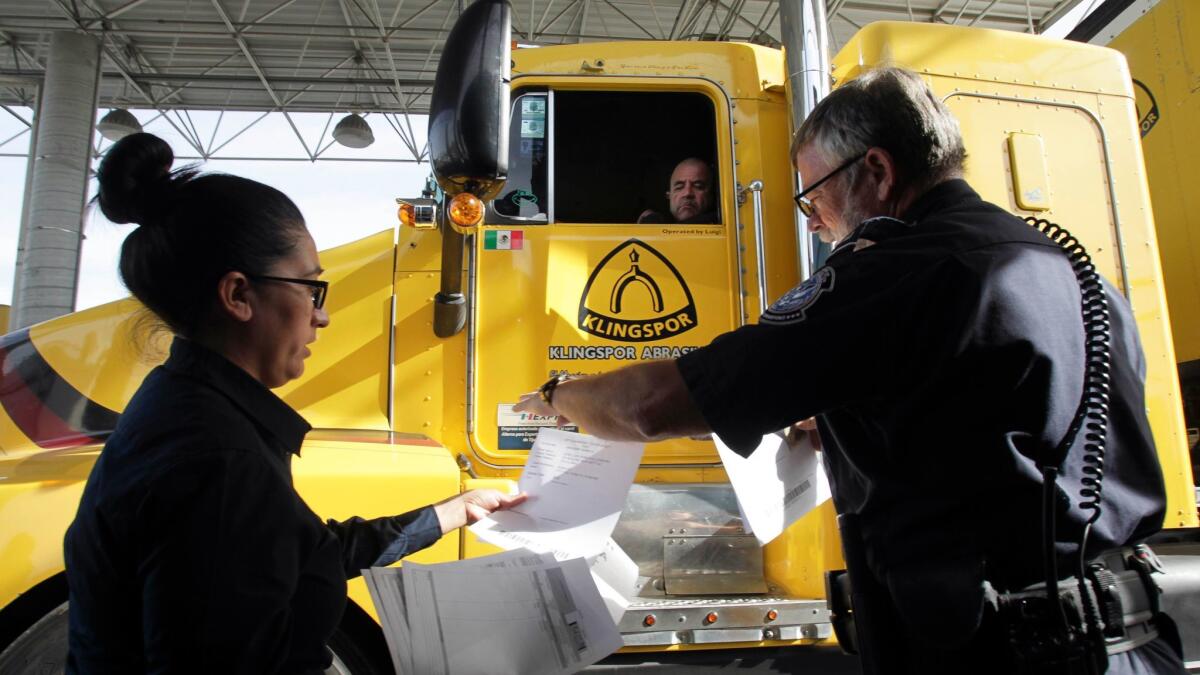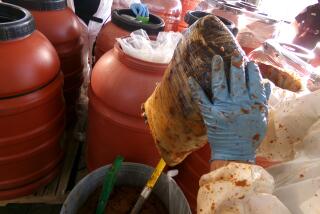A time saver: Joint U.S.-Mexico cargo inspections launch at a San Diego border crossing

In a move expected to dramatically reduce wait times for hundreds of trucks that each day move goods from Tijuana to San Diego, Mexican customs officials for the first time are working side by side with their U.S. counterparts at the Otay Mesa Port of Entry.
Under a pilot program formally launched Friday, U.S. and Mexican officials operate out of adjacent booths at the busy U.S. port, working separately but simultaneously as they carry out inspections on products crossing into the United States — everything from tomatoes to televisions.
Known as Unified Cargo Processing, the program has proven successful at other ports of entry on the U.S.-Mexico border, including Nogales, Douglas and San Luis in Arizona and Calexico across from the Baja California capital of Mexicali. Wait times have plunged by as much as 85% for qualifying shippers.
The Otay Mesa Port of Entry is the second busiest U.S. commercial port of entry on the Mexican border, with an average of more than 3,500 truck crossings per day, according to U.S. Customs and Border Protection. The process of entering San Diego can stretch to five or six hours if the truck is twice pulled over for secondary inspection — first as it leaves Mexico, and again as it enters the United States.
Early Friday afternoon, a line of trucks streamed steadily from Tijuana into the Otay Mesa Port of Entry. In one lane, drivers leaned through their windows as they handed paperwork to Michael Horn, a U.S. Customs and Border Protection officer. Horn immediately shared some of the documents with Rosa María Barrientos — an official with Mexico’s Tax Administration Service — who worked in a separate booth. Within minutes, the truck in question was cleared to continue to the United States.
Had either of the officers questioned a shipment, the truck would have been pulled over for an inspection conducted jointly by U.S. and Mexican officials.
The joint inspections involve only about a third of the northbound truck traffic, limited to shippers who are enrolled in a trusted traveler program known as Customs Trade Partnership Against Terrorism.
Companies in Tijuana’s booming manufacturing industry are expected to benefit from these inspections as they export products such as televisions, audio speakers, prosthetics and pacemakers from Mexico to the United States.
Toyota, which operates a Tacoma pickup manufacturing plant in Tijuana, is among the main potential beneficiaries.
U.S. customs officials have said they expect the program to cut inspection times in half.
The new system underscores the collaboration at the border between the U.S. and Mexican agencies. “We’re building upon the structures and procedures that are already in place,” said Larry Fanning, assistant port director for trade at the Otay Mesa Port of Entry.
The joint inspections at Otay Mesa began more than two years after the U.S. and Mexico launched a pilot pre-inspection program that has had U.S. and Mexican officials working together at a facility in Tijuana to inspect agricultural goods crossing from Baja California to San Diego.
The collaborative efforts are seen as a way to increase efficiency even as the U.S. and Mexican governments have struggled with limited funding to expand ports of entry and build new ones.
Meanwhile, this is a time of uncertainty over the future of commercial relations between the United States and Mexico, as the North American Free Trade Agreement is being renegotiated.
“We are not waiting to see what happens,” said Luis Hernández, president of the Tijuana Maquiladora Assn. “We are moving forward.”
sandra.dibble@sduniontribune.com







